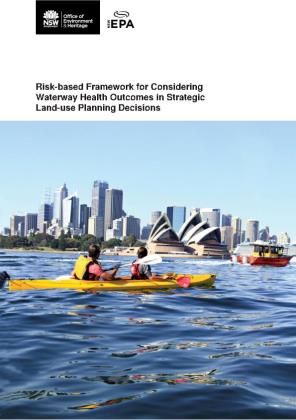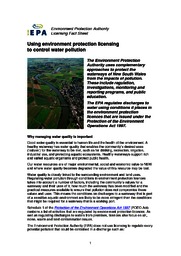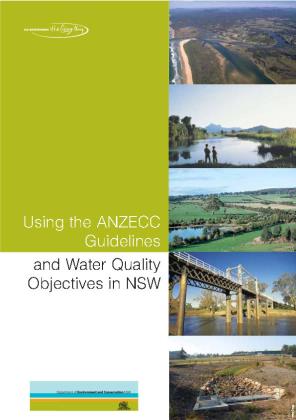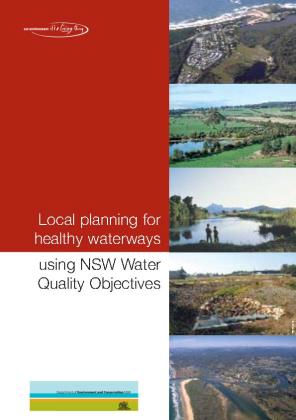Risk-based framework for considering waterway health in strategic land-use planning
The NSW Government has developed a Risk-based Framework for Considering Waterway Health Outcomes in Strategic Land-use Planning Decisions. This gives a structured approach to
- considering how land-change may affect waterways
- identifying appropriate management responses.
Who should use the framework?
- Strategic lang-use planners
- Water utilities
Why is the framework needed?
The framework brings together existing policy and guidelines in the National Water Quality Management Strategy.
By using the framework, practitioners can identify least-cost management responses across all sources of waterway impacts to meet specified outcomes for water quality and river health.
Approved methods for the sampling and analysis of water pollutants in NSW
The Approved Methods for the Sampling and Analysis of Water Pollutants in New South Wales (PDF 1175KB) lists the sampling and analysis methods to be used to test for the presence or concentration of matter in water and the volume, depth and flow of water or wastewater, when complying with statutory requirements.
Alternative and modified test methods
If you want to use alternative or significantly modified test methods for water you must ask the EPA in writing for approval. The Approved Methods explains when you’ll need approval.
Considering environmental values of water when issuing prevention notices
The EPA and other regulators use the guideline Considering Environmental Values of Water when Issuing Prevention Notices (PDF 634KB) when issuing prevention notices under section 96 of the Protection of the Environment Operations Act 1997 (POEO Act).
Use of effluent by irrigation
Irrigating with effluent can make a significant contribution to reducing water demand, improving soil condition and reducing the amount of pollutants discharged into our waterways. But it must be done in a way that protects the environment and human health.
Guidelines and reports
- Environmental Guidelines: Use of Effluent by Irrigation (PDF 2MB)
- a guide to using effluent in an ecologically sustainable and socially responsible way
- educational and advisory, not a mandatory or regulatory tool
- does not introduce new environmental requirements
- Indicators of Sustainability for Effluent Reuse in the Intensive Livestock Industries: Piggeries and Cattle Feedlots is
- available from Australian Pork Limited (APL)
- created by APL, Meat and Livestock Australia and the EPA
- identifies indicator parameters and monitoring procedures for individual piggeries and cattle feedlots based on site-specific environmental risk
- useful to other industry sectors.
- National Guidelines for Water Recycling
-
released through the National Water Quality Management Strategy and adopted by NSW
-
focuses on assessing and managing risk to human health
-
most relevant where people are exposed to recycled water such as in urban re-use schemes
Where there are regulatory systems in place that relate to recycling, such as the NSW Water Industry Competition Act 2006and Local Government Act 1993, the regulatory agency should be consulted to clarify requirements.
-
- Effluent reuse management: Strategic environmental compliance and performance review
Use and disposal of biosolids
Biosolids are a by-product from treating sewage. Solids produced during the various stages of sewage treatment, often called wastewater solids or sewage sludge, are collected and further processed. Once they are suitable for use they are called biosolids.
The NSW Government encourages the beneficial use of biosolids where
- it is safe and practicable
- it provides the best environmental outcome
Where beneficial use is not possible, biosolids must be disposed of safely and lawfully.
The NSW Environmental guidelines: Use and disposal of biosolids products (PDF 556KB)
sets out requirements for the beneficial use and disposal of biosolids products to land in NSW. It is for
- planners, designers and operators of sewerage systems
- people who process or use biosolids products, by establishing requirements for the beneficial use and disposal of biosolids products to land in NSW
These guidelines were released in October 1997. Since then there have been changes to the overarching legislation for environmental protection in NSW and to the regulation of biosolids use and disposal. For the current regulatory requirements, see waste regulation, licensing and compliance.
Licensing guidelines for sewage treatment plants
Licences for sewage treatment plants cover entire sewage treatment systems, including overflows from pumping stations and reticulation systems. This is to minimise the potential harm to human health and the environment from the release of sewage into the environment. Sewer overflows are one of the most significant diffuse sources of water pollution in urban areas.
Guidelines
Licensing Guidelines for Sewage Treatment Systems (PDF 174KB)
is for licensees in non-metropolitan areas, generally local councils and other water authorities. It describes the requirements for sewage treatment systems other than those operated by Sydney Water and Hunter Water (which have a separate licensing process).
The document explains
- what sewage treatment system licences are
- the potential impacts of sewer overflows on human health and the environment
- the EPA's approach to managing sewer overflows
- licensing techniques to minimise sewer overflows








